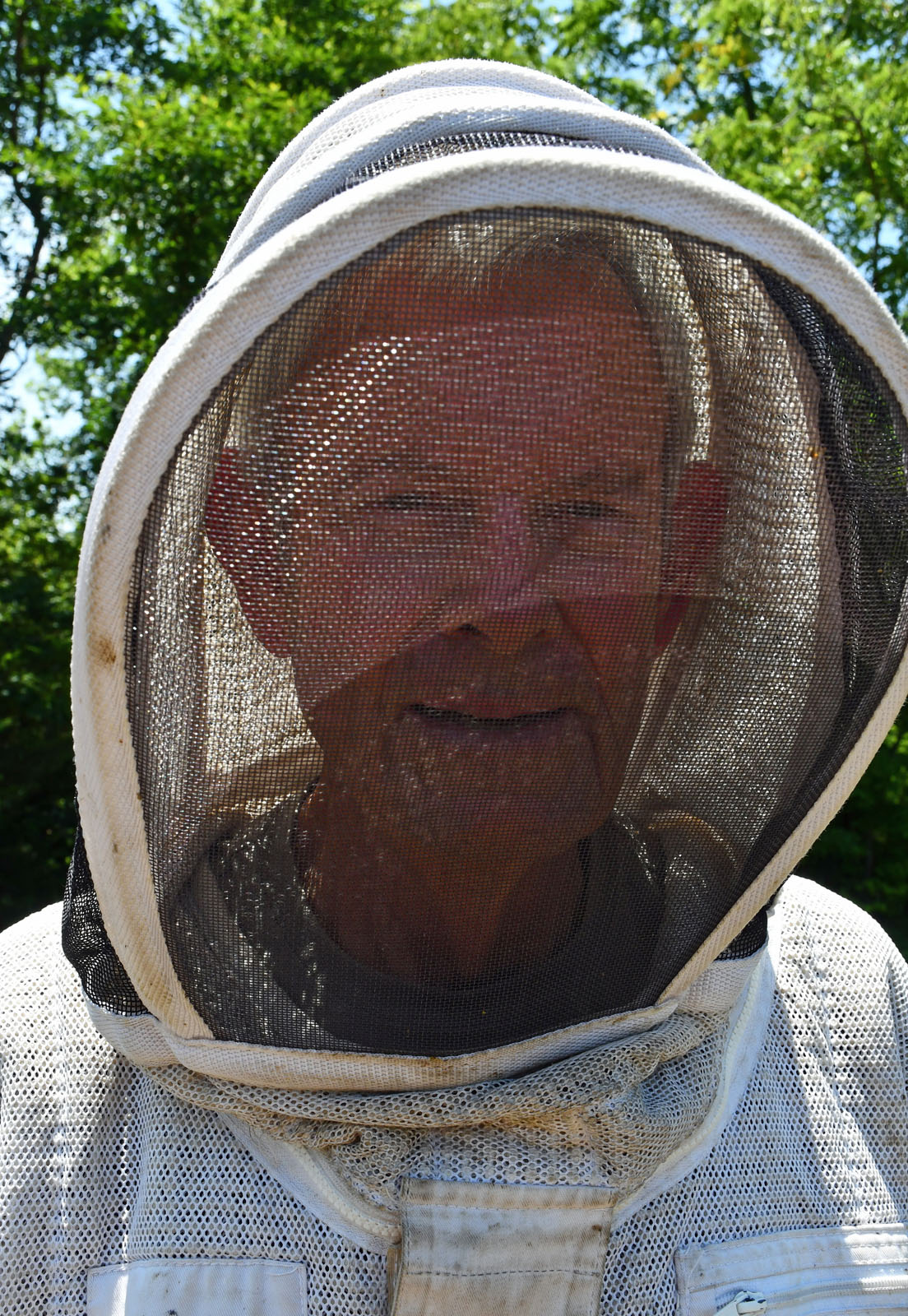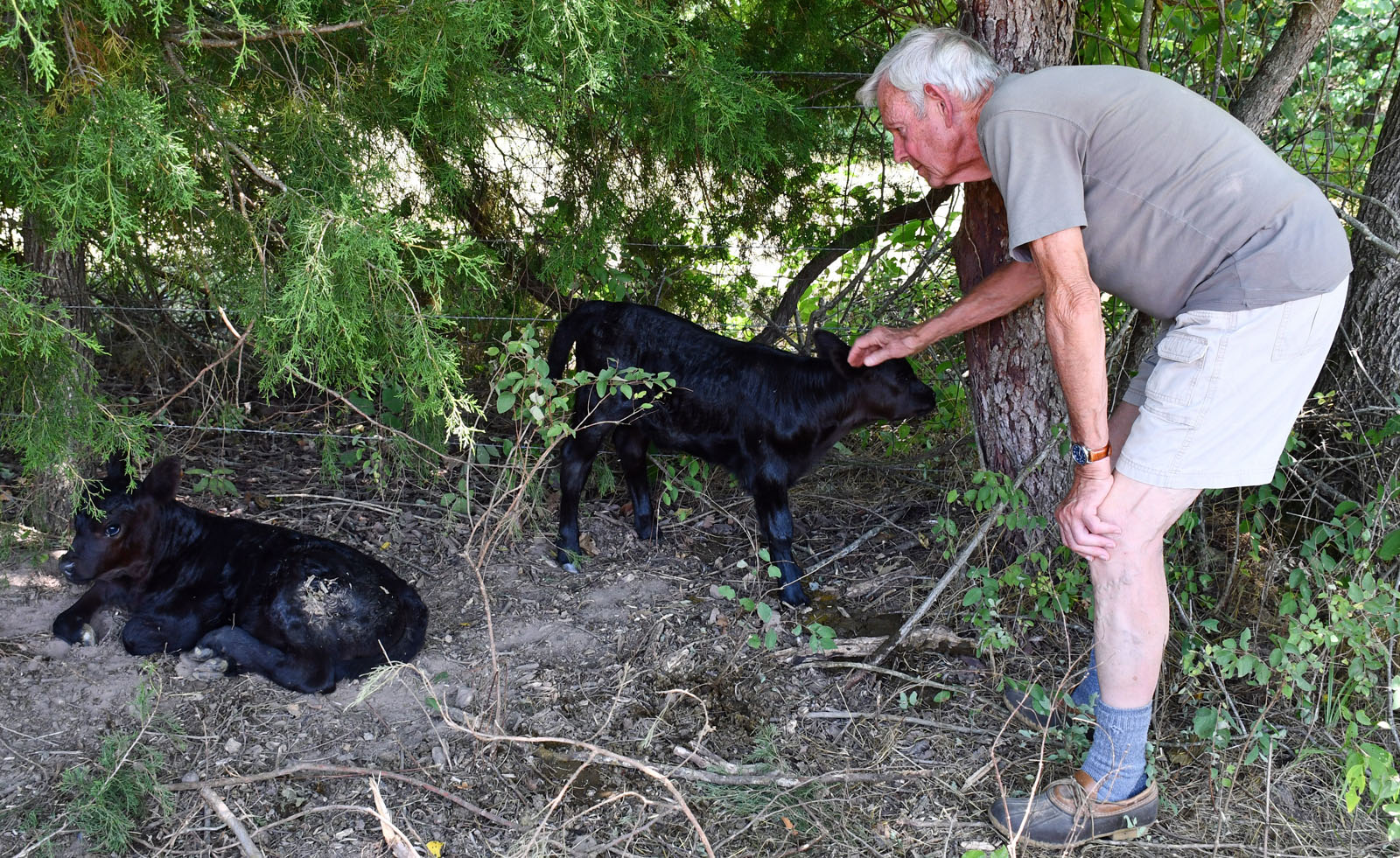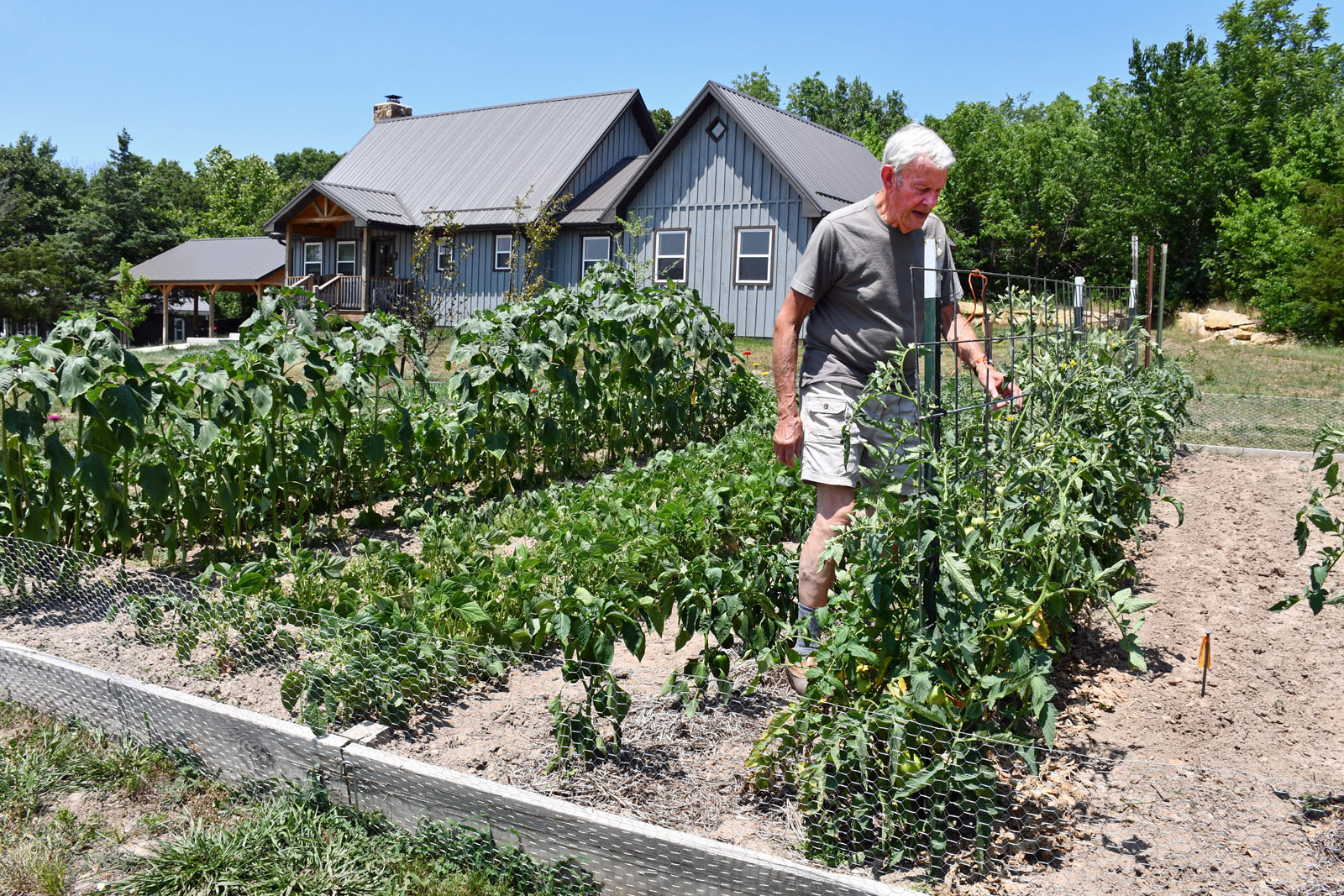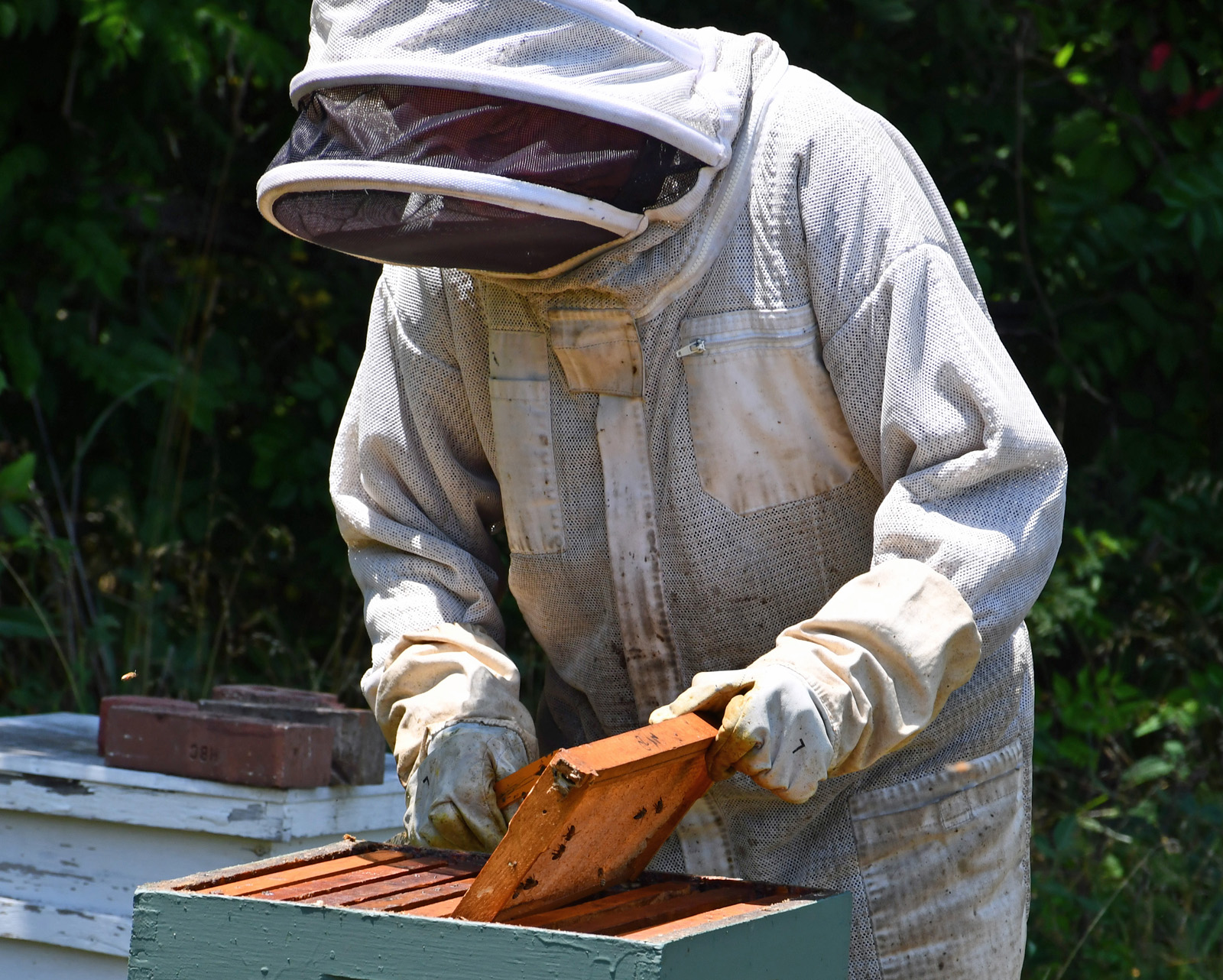After four decades in education, including 22 years as president of Drury University, John E. Moore Jr. has switched from leading faculty and students to wrangling honey bees.
“Bees are social creatures and behave in predictable ways,” says Moore, comparing the two management roles. “That’s not to say that college faculty and students don’t — but they specialize in a lot of different things and they go in a lot of different directions. Sometimes it was like trying to herd cats.
“But they all respond to attention and support and understanding, and patience is key, as well.”
Switching from a bustling urban campus to 55 quiet rural acres in north-central Greene County may seem a surprising turn for someone with Moore’s professional resume. In addition to his 1983-2005 tenure at Drury’s helm, he earned bachelor’s and master’s degrees from Yale University and a doctorate from Harvard, served eight years as an assistant to Missouri’s commissioner of education, and held teaching and administrative roles at schools in St. Louis, North Carolina and Greece.
However, for Moore, the move to the farm was a sort-of homecoming.

Born 80 years ago in Aurora into a family with roots in Monett, Moore was greatly influenced by his grandfather Leo Harback. “I didn’t grow up on a farm, but my grandfather, who was a railroad engineer with the Frisco, had a farm. He ran Angus cattle and he kept some bees. When I helped him with the bees, he’d tease me and say, ‘If one of those bees stings you, I’m going to charge you a dime because that bee will die.’
‘My grandfather was my model'
“He’d put me in his truck when I was 12 years old, and I’d drive it on the farm, jumping it around with the clutch and stick. I helped with bucking hay bales, stringing barbed wire, picking strawberries, feeding the cattle — even holding down little bulls while he put Elastrator bands on them. And he always had a big garden. I loved all of it.
“I didn’t realize until many years later how much that relationship meant to me. My grandfather was my model. I was close to my dad (John E. Moore Sr.) — we’d fish and quail hunt together — but it was my grandfather who really colored my interests.”
So in 2010, Moore enrolled in a beginner’s beekeeping class presented by the Beekeepers Association of the Ozarks, and the next year he started installing hives on his acreage and populating them with colonies of the Carniolan subspecies of European honey bees.

He also acquired a few Angus. “American Aberdeens, which are about two-thirds the size of big Angus,” he specifies. “I have 10 head right now. They are very sweet cattle, very gentle-natured. They’re more pets than anything else — all of them are named. Two are new little guys; their names are T-Bone and Sirloin. I will take care of them and feed them, and then one day they will feed us.”
And he put in a garden, growing tomatoes, peppers, onions, okra, and green beans, plus flowers including zinnias, marigolds and sunflowers.
“I had to import dirt because all we have here is rock,” says Moore. “If rocks were potatoes, we could feed the world off this farm.” In fact, he has dubbed the place Worm Rock Farm because many of the rocks found on his land contain fossilized traces of prehistoric worm trails.

But it’s the bees that are gaining Moore a new semi-professional reputation.
He now teaches some courses for the beekeepers’ association. And he conducts tours and workshops at his farm, which has a Willard address and on which he presently has 25 bee hives.
“Most people only know three things about bees,” Moore says. “That bees make honey and that they can sting; and people are vaguely aware that there are worries about declining populations of bees.”
Some of the information he tells novice beekeepers and other interested members of the general public includes:
“In winter, a hive’s population might be only 10,000, maybe 15,000 or 20,000 bees. They don’t really hibernate; on a nice day in the winter, the bees will be out flying. Then in late January or early February, the queen — each colony has a queen — she starts laying eggs, building up the population for the spring honey flow. By late May or early June, there could be between 50,000 and 60,000 bees per hive.
“The honey flow extends from April through May and into June, when flowers are blooming and there’s nectar and pollen. The pollen that the bees pick up and carry not only fertilizes the plants they land on, there’s protein in it for the bees. And the nectar gives them the carbohydrates they need to refine honey. It’s fascinating,” Moore says.
In addition to the hives on his own farm, Moore also keeps colonies on a friend’s farm near the Greene-Polk county line, and at the Missouri State University Fruit Experiment Station at Mountain Grove.
“It’s kind-of like pasture for your cows. There’s only so much forage, and you want to have locations where there’s adequate forage for the bees because they eat it up. Bees will fly out from their hive up to two miles in search of pollen and nectar.”
Clover is a favorite food source for bees. “They like all kinds of clover. There’s the white Dutch clover, as it’s called; there’s sweet yellow clover; and there’s crimson clover,” he notes. “And clover honey is very popular.”
The pollen that bees help distribute contains male sex cells necessary for plant production.
‘Possibly a third of the food that we eat depends on pollinators'
“Possibly a third of the food that we eat depends on pollinators — apples, pears, peaches, blueberries, and many others,” Moore points out. “And probably three-quarters of the pollinators are honey bees. That’s why there is concern expressed when bee populations are reported to be declining in some areas.”
A classic example of the vital role of bees in nature’s reproductive cycle is found in almond groves, he says. “Almond growers in California depend totally on honey bees to pollinate the almond crop. The growers even rent bee hives from all over the country. They haul them out there in tractor-trailer trucks. It takes at least one strong hive, and sometimes they’ll put two hives on an acre of almonds. The going rent rate is anywhere from $160 to $200 per hive for a couple weeks’ work. There wouldn’t be an almond crop without the bees.”
The threat to the bee population is three-fold: Pests, pesticides and poor nutrition.
Some insecticides sprayed on farm crops, and even common products such as Sevin popular among urban gardeners, can be fatal to honey bees if not used judiciously. And modern efforts to rid rural roadside ditches and fencelines of flowering weeds rob bees of natural native forage.
Beekeepers must be vigilant against pests that can invade hives.
“Wax moths can get in and really mess up a hive. Small hive beetles will slime a hive if they get in. And there are pathogens, some bacterial and viral infections that afflict bees, although we don’t see that much here in the Ozarks,” says Moore.
“The big challenge we have here is Varroa mites. They have been a big bugaboo for the past 20 years. They are like tiny ticks that get on bees and suck their blood. There are certain miticides you can use. Thymol, made from the herb thyme, is one; and a new thing is oxalic acid, which can be applied as a vapor or with a drip.”
The bottom-line goal for most beekeepers is to collect honey for personal consumption and-or for sale. Efficient manmade hives to house the bees are a series of wooden boxes stacked like multi-story apartment buildings.
“The bottom two boxes are for the bees,” Moore explains. “The one at the very bottom is the brood box to hatch out baby bees. The next one up is a second brood box or for honey storage for the bees’ use.

“The upper boxes are for what we call the ‘honey supers.’ The name comes from the fact that they are superimposed on top of the brood area of the hive. That’s where we harvest the honey that the bees produce.
“And, by the way, we’re not robbing the bees of their sustenance — we leave a box of honey for the bees, to sustain them through the winter. And generally we also do supplemental feeding during the winter by putting granulated white sugar in the hive, carbohydrates to give them energy.
‘As long as you're not bothering them, they don't bother you'
When inspecting the hives closeup and especially when harvesting honey, Moore wears a head-to-toe protective suit and boots and deerskin gloves. However, he says, “The bees we have around here are pretty gentle. I can even walk around the hives without the protective gear and not get stung. As long as you’re not bothering them, they don’t bother you.
“Oh, they can get a little pissy and mean when you’re pulling their hive apart. I do get stung once in a while. The good news there is that I’ll probably never get arthritis,” he says with a chuckle, referring to research that indicates bee venom can alleviate bone joint pain.
“But by and large, our honey bees are gentle creatures and aren’t dangerous — unless, of course, you’re allergic, and then a bee sting can send you into anaphylactic shock.”
Moore insists he is a “pure hobby farmer” and “just a practical beekeeper” who doesn’t produce vast quantities of honey for sale. “I’ve always made more than enough from the honey to pay for the production of the honey,” he assures. He predicts he’ll get 40 to 50 gallons of honey from his hives this year. “But I haven’t set any specific goals.”

One thing that Moore and fellow local beekeepers wish that the general public would do is alert the Beekeepers Association of the Ozarks if a swarm of bees is spotted. Swarming is a natural process that allows formation of a new colony when a hive gets overcrowded. Calling an exterminator or attacking the swarm with chemical sprays or a water hose is the wrong reaction, they say.
“When bees get a sense that a hive is too crowded, the old queen will leave with about half the bees in that colony, and send out scouts to find a place for them to create a new hive,” Moore says.
“Along the way, they may hang on a post or a house or something, a big gob of bees. We have what we call ‘swarm-catchers’ who will come out and collect those bees and help them on their way.”
Moore himself was called upon to catch a swarm this past spring. “It was a big one, a block off Commercial Street near Grant Avenue. They were on the bottom of an electrical box on a house. The idea is to get the queen into a box, and then all the others will run in there after her.
“I just gathered them up with my hands and started putting them into a box. I didn’t get them all, so I left the box to sit there overnight. When I came back the next morning, all the bees were in the box. They’re going gangbusters for me now making honey.”
The Beekeepers Association of the Ozarks can be reached by phone at 417-319-1539, or nearby swarm-catchers can be contacted directly by checking a list posted on the group’s website, ozarksbeekeepers.org.
Meanwhile, back at the old hive, the departed queen will have left behind some queen cells from which a new queen can be hatched. The remaining bees nourish the cells through the egg, larva and pupa stages with a secretion called “royal jelly.”
“The first one that hatches will run around and kill all the other queens still in their cells,” says Moore. “And then she will fly out through a congregation of drones, where she’ll be bred by a half-dozen or more, which ensures genetic diversity. She’ll receive enough sperm to allow her to fertilize eggs for several years, and will never be bred again. It’s interesting biology.”
Moore likens his experiences with bees to his earlier career in education. “I keep learning stuff, new things,” he says. “I’m always trying different configurations with hive boxes, for instance, learning what works and what doesn’t. It’s an ongoing process.”
In addition to expanding his knowledge through study and experimentation, he says he likes to work with his hands.
‘Along the way I taught myself some things'
“I’m not perfect at anything, but I enjoy doing it. When I was in high school, I wanted to take mechanical drawing and shop courses, but they said ‘Oh, no, you have to take college prep courses.’ But along the way I taught myself some things.
“I can do a little carpentry and I’m a shade-tree mechanic. Recently I learned how to install a solar-powered electric fence by myself for the cattle. If you have a farm, even a small one, you have to know how to do a little bit of this and a little bit of that.”

Moore says he enjoyed his career in the education field. “I was very fortunate to work with and come into contact with great people. I enjoyed those relationships very, very much.
“But I’m happy to be out here taking care of bees and little black cows and trying to raise good pasture in this pretty little corner of the Ozarks. I get up early-early, make coffee and sit out on the porch and contemplate the world and my place in it. And after working all day, cutting brush and fixing fence and taking care of my critters, I sit out there again in the evening.
“I’m not just happy — I’m really content.”


